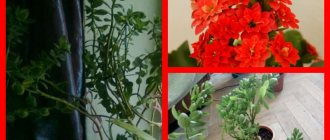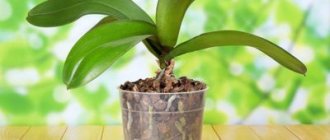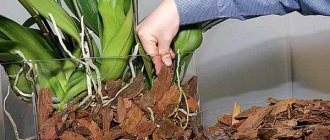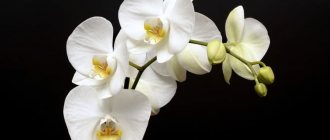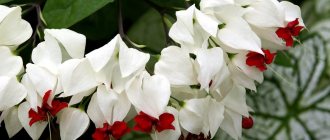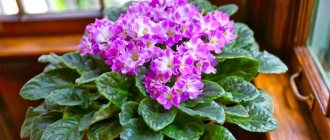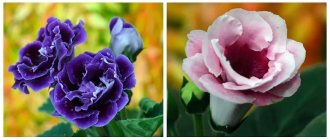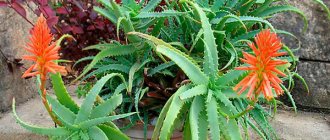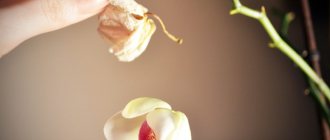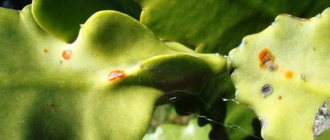The purpose of using growth stimulants when growing orchids
The issue of using stimulants when growing orchids is a very delicate one. Some experts do not recommend getting carried away with them, considering artificial stimulation harmful to epiphytes:
“Stimulants must be handled carefully. Often gardeners squeeze all the reserves out of a plant, and then are surprised that their orchids quickly age and stop blooming. Epiphytes, in fact, grow and bloom beautifully without any stimulants, if you create the right conditions for them - good light and aeration of the roots, proper watering and moderate mineral supplements.”
A. Davydovskaya, owner of the orchidarium
However, in practice, it is not always possible to create ideal conditions for orchids. Plants stop growing, freeze in the dormant phase, refuse to bloom, and get sick. Therefore, from time to time you have to resort to stimulation.
If the plant is left without roots
In fact, bringing your beauty to this state is not at all difficult. Incorrect watering and temperature conditions - and after a while you notice that growth has stopped and the leaves have wilted sadly. After shaking it out of the pot and checking the condition of the roots, you come to the conclusion that there is nothing left to save. Throw away the plant? No, it is quite possible to revive him. You will need time and a vitamin cocktail for an orchid without roots. But first, let's talk about the sequence of the procedure:
- It is necessary to cut off all the rot that was found. If the slightest piece remains, it will affect healthy tissue.
- Tools must be calcined and treated with alcohol.
- Crush the activated carbon and lubricate the cuts with it.
All that remains is to place the plant in the greenhouse for 2-3 days. To do this, take a large bag, at the bottom of which a tray with wet moss is placed. The orchid is suspended above the surface without touching it. But you can do it easier by placing the plant in an empty pot. It will go about 72 hours without watering.
Classification of stimulants by active ingredients
The active components of growth stimulants may be different. On this basis they are classified as follows:
| Active components of the stimulant | Effect on orchids | Purpose |
| Phytohormones auxins, cytokinins, gibberellins | They activate the elongation and division of stem or root cells, the formation of buds, and accelerate flowering. | Stimulation of growth and flowering of orchids. |
| Phytohormones brassinosteroids | They stimulate the development of seedlings and support immunity in unfavorable conditions. | Relieving stress after exposure to adverse factors, increasing resilience. |
| Vitamins | They enhance the circulation of nutrients in tissues, affect the formation of enzymes, the intensity of photosynthesis, and relieve the consequences of harmful influences. | Stimulates growth and flowering, increases resistance to adverse factors, restores immunity after stress and illness. |
| Amino acids | They increase resistance to osmotic or temperature stress, regulate the functioning of stomata, stimulate the synthesis of their own phytohormones, increase resistance to infections, and activate growth and flowering. | Stimulation of growth and flowering, root formation, increasing resistance to adverse factors, restoration of the lost root system. |
| Organic acids (succinic, citric, malic) | They improve cellular respiration, enhance mitochondrial function and metabolism, accelerate the formation of roots and shoots, increase the length of peduncles, the number and diameter of flowers. | Stimulation of growth and flowering, increasing resistance to adverse factors. |
| Microelements | They influence all biochemical processes, participate in the construction of cells, activate photosynthesis and nutrient transport. | Stimulation of growth and flowering, elimination of mineral starvation, increasing the decorativeness of orchids. |
| Glucose | It is a source of energy for cells, participates in the formation and storage of its own sugars. | Restoration of weakened orchids that have lost leaf turgor, stimulation of their growth, adaptation to lack of irrigation. |
From the table above it is clear that the stimulating effect can be produced in different ways. Some stimulants cause cells to rapidly divide and stretch, others act more gently by increasing the metabolic rate and improving the nutrition of orchids.
Multiflor
Description
What element is your orchid missing? It's not easy to determine :
- Those who offer Multiflor Aqua fertilizer advise not to think about it. If you have their product on hand;
- Liquid complex mineral fertilizer with microelements in chelate form. Suitable for all types of orchids. The presence of a number of microelements emphasizes its versatility for many orchids: Iron;
- Cobalt;
- Boron;
- Copper;
- Manganese;
- Molybdenum;
- Zinc;
- Humic acid;
- Succinic acid.
Multiflor is also available in another form . Crystalline. Easy to remember: 50 grams of the drug per 50 liters. Excellent solubility and 100% digestibility by plants. It's even cheaper than liquid.
What is it used for?
You need to use it for :
- Bud formation;
- Increasing the duration of orchid flowering;
- More active root formation;
- Increasing the decorativeness of flowers.
Increases the immunity of plants and their resistance in the event of adverse situations.
Mode of application
How to breed Multiflor?
- The liquid state of the fertilizer and the measuring cap allow you to quickly prepare the required solution : Pour 1 liter of settled water into a container;
- Pour in one capful of fertilizer (this is 7.5 ml);
- Stir well;
- Pour into a container (1.5 l plastic bottle). And add water;
- The solution can stand for 30 minutes.
In what phases of development is it most effective?
- It can be used even during the rest period . If your orchid species has it;
- But its greater effect is manifested when buds appear. The number of such buds increases significantly when feeding with Multiflora. And they bloom longer;
- During the growing season , use 1-2 times every 7-10 days. And during the dormant period, 1-2 feedings per month are sufficient;
- After transplanting the plants, fertilizing begins in 7-14 days.
Some people use Multiflor; reviews from amateur gardeners are presented below.
Reviews
Michael. “I have been using this product for over a year now. And I don't want others. Very fast preparation. It lasts a long time. After a year of use, more than a third remained. The most important thing is that it is very effective. When using it, the orchid produces almost 40 buds. And large flowers."
Zhanna. “There are many different fertilizers. As you read, you want to apply everything. And the result is immediate. I settled on one main thing. Microflora. It is very convenient to work with him. 10 grams per 10 liters of water. Enough for my orchids. I use it for watering. The rest are in between. I want to warn big fans of fertilizing. Choose 2-3 products. And be careful with medications. And bird droppings."
Growth stimulants based on phytohormones
This is the most popular, but also the most problematic group of growth stimulants. The peculiarity of phytohormones is that when they are in excess, they can have the exact opposite, inhibitory effect on plants. Orchids are more sensitive to such influences than other plants, so such preparations must be used very carefully when growing them.
Phytohormonal stimulants should be used strictly according to the instructions, avoiding overdose, and only when absolutely necessary. To reduce the likelihood of negative consequences, you simultaneously need to feed orchids and adjust lighting, air temperature and irrigation frequency
The most famous and effective phytohormonal stimulants are the following:
- Heteroauxin. Often used to stimulate the growth of the root system during the resuscitation of orchids. Available in powder or tablet form. The average cost of a package is 30 rubles.
- "Bud". The drug is based on the phytohormone gibberellin. It is used to stimulate the flowering of orchids and increase the number of flowers on the peduncle. Available in water-soluble form. The average price of a package is 40 rubles.
- Cytokinin paste. Used to activate the formation of peduncles or children, to stimulate the opening of the lateral buds of the orchid. Produced by many manufacturers at prices ranging from 80 to 150 rubles.
- "Epin-Extra". The safest of the hormonal stimulants, based on epibrassinolide, is a phytohormone from the group of brassinosteroids. It is used to increase the immunity of orchids, improve their adaptation and growth rate. Available in the form of a solution at a price of 15-20 rubles per ampoule.
Slightly less often, orchid lovers use such drugs from this group as “Ovary”, “Kornevin”, “Gibbersib”.
Castor oil
Description and useful properties
- Castor oil is known as ricin oil : A very good remedy for increasing the thickness of eyebrows and eyelashes. If you are not allergic to it;
- A good antiseptic. Known medicinally as a laxative;
- In India it is used for lighting - it burns for a long time without odor. Made from castor bean seeds.
Castor oil strengthens plants well.
- They recommend it to strengthen the plant. Orchids grow better, more buds form and bloom better;
Preparation of the solution
It's good for you to know. Castor oil is the densest plant oil .
One teaspoon of castor oil is diluted in 1 liter of water . Stir well and spray the plants.
Important! Shake the oil and water well in a container. Water without delay, immediately. To prevent oil droplets from forming.
The most favorable time for feeding
- Do not use during the plant's dormant period. Not only is it beneficial, it will bring more harm during this period;
- During the growing season and the formation of buds, its effectiveness is highest.
Gardeners like to use castor oil on their orchid.
You can read reviews about castor oil below.
Reviews
Galina. “I used castor oil quite often as a cosmetic product. Eyebrows, eyelashes. Dry skin after winter. It helps a lot. Although I don't really like the smell. I tried it on orchids. Can be purchased freely at the pharmacy. And inexpensive. I used it for a month. I was very surprised by its effectiveness. They have become noticeably stronger, and buds have already formed. At least you need to mix it for a long time in warm, settled water. Spraying helps distribute it evenly. I'm looking forward to flowering."
Georgy. “Castor oil has an enveloping property. It closes spores in plants. And it can oppress them. Never used it. I don't recommend it to others either. Use as directed. Like a laxative."
The use of vitamins to stimulate the growth of orchids
Experienced lovers of epiphytes often use ordinary pharmacy vitamins in ampoules to stimulate the development and strengthen the immunity of orchids. The most effective in this regard are the following:
- vitamin C;
- B vitamins (B1, B6, B12);
- nicotinic acid (vitamin PP).
These vitamins are diluted in water at the rate of 1 ampoule per 1 liter. With the resulting solution, you can either water the orchids once every 2 weeks, or spray them on the leaves once every 10 days.
Vitamins are often included in ready-made stimulants. One of the most popular is Bona Forte orchid tonic. It contains ascorbic and nicotinic acids, as well as vitamin B1.
Tip #1. Vitamin C is used to stimulate the immunity of orchids and protect them from environmental factors. Vitamins B1 and nicotinic acid are suitable to improve the condition of the roots and increase their growth rate. Vitamins B6 and B12 work well when resuscitating orchids.
Growing new roots
When the drying period ends, you can fill the pot halfway with pieces of pine bark and place our orchid on this substrate. Now she needs foliar feeding to maintain strength and nutrition. Don't forget to cover the pot with a dome made from a large bag. Otherwise, it will dry out greatly and may die.
The easiest way is to choose a ready-made composition from a special series for orchids. The most famous brands are Doctor Foley and Bene Forte. Choose those that are designed for foliar feeding. And be patient, this will definitely be required to resuscitate the orchid. The vitamin cocktail should be diluted in the recommended proportion and sprayed on the green part. The cutting itself, which will be the place where new roots appear, should be moistened with plain water from a spray bottle.
The process of returning to life takes about 6 months. Yes, don’t think that in a week there will be new roots? or suddenly a flower stalk will begin to grow. She's having a really hard time right now.
The best amino acid stimulator for orchids
A drug called “Ribav-Extra” is very popular among orchid growers. Its peculiarity is that it exhibits the properties of not only a stimulant and antistress, but also a therapeutic agent.
The drug “Ribav-Extra” is based on an amino acid complex consisting of the following amino acids:
Amino acids are absolutely safe for orchids. Very low concentrations of working solutions are not associated with phytotoxicity, but with the high ability of amino acids to exhibit biological activity in ultra-low doses
- L-alanine – activates photosynthesis and increases the cold resistance of orchids and their immunity to drought;
- glutamic acid – stimulates the growth of stem and root cells, regulates the functioning of stomata, increases immunity to drought and resistance to pathogenic microorganisms.
Most often, “Ribav-Extra” is used in the resuscitation of orchids as a root former instead of the rather problematic “Kornevin” or “Heteroauxin”. But spraying on leaves is also successfully practiced and brings good results.
"Ribav-Extra" is used in ultra-small doses. To work with orchids, 1 drop per 1 liter of water is enough. At a price of 30 rubles per 1 ml, this drug is used quite economically.
Root formers
To enhance the development of the root system, when necessary, it is recommended to use root stimulants, such as:
- Kornevin;
- Embiko;
- Ribav-Extra.
The main component of all these drugs is the orchid growth hormone heteroauxin , which promotes accelerated growth and development of root cells.
Heteroauxin is added to all root-forming preparations.
In addition to it, fungicides are added to the preparations , preventing the development of pathogenic microflora, or a starting set of microelements, which ensures healthy, full-fledged cell growth.
When using Kornevin powder, it is recommended to dilute it with crushed activated carbon, which acts as an antiseptic and is used to prevent the occurrence of fungal and bacterial diseases of orchids.
Complex stimulants based on minerals, sugars and organic acids
This group includes drugs that combine the stimulating properties of various biologically active substances. It includes the following organomineral complexes:
For rich flowering, orchids must have a good supply of nutrients in their tissues. It can only be ensured by the comprehensive influence of different components.
- “ REASIL for orchids” is a chelated complete mineral complex with nitrogen, phosphorus, potassium, boron, iron, zinc and other trace elements. The composition includes the amino acid lysine, B vitamins, ascorbic, succinic and citric acids.
- “ Joy Growth and Flowering Activator for Orchids” is an inexpensive tablet complex of succinic acid and chitosan. Chitosan is a sugar that is widely used in professional plant growing due to its powerful growth-regulating properties. Succinic acid is a substance that itself is often used by orchid lovers to resuscitate plants.
- “Immunocytophyte” is a compound of urea with ethyl ester of arachidonic acid. A strong immunoprotector that protects orchids from fungal diseases. Thanks to urea, it stimulates the growth of leaf apparatus.
- “Stimulus” is a complex of amino acids and microelements (boron, zinc, manganese). Stimulates the regrowth of peduncles and flowering of orchids, increases the decorativeness of leaves, and protects against external stress.
Drugs in this group are preferable to others. They do not work one-sidedly, drawing out resources, but in a comprehensive manner - they simultaneously stimulate and nourish the plants.
Basic elements for color formation
Inorganic mineral complexes in liquid form are considered the optimal additional nutrition for phalaenopsis.
They contain a full range of macro- and microelements necessary for development. And although their composition is quite rich and includes not only basic (N, F and K), but also other macro- (Ca, Mg, Fe, etc.) and microelements (Zn, B, Cu, Mn, etc.), on the packaging Basically, the ratio of only the main 3 elements is indicated.
During the formation of flowering arrows and in general for flowering, this ratio should look something like this - 2:6:6 or 4:8:8.
Nitrogen
This element is responsible for the growth of vegetative mass . The orchid needs to increase its leaf mass and fully develop it. Poorly developed foliage significantly reduces the feeding area, which often leads to the death of orchids.
It is necessary to use fertilizers containing nitrogen, phosphorus and potassium.
It is advisable to use complex fertilizers or special fertilizers “For orchids”, which mainly contain nitrogen. For example, “Uniflor-rost”, “Kristalon red”, etc. Experienced orchidists advise reducing the dosage by 3-4 times the recommended one.
Important! You should know that the application of fertilizers with a high nitrogen content before flowering (30-50 days in advance) is either significantly reduced or completely eliminated.
Nitrogen oversaturation causes:
- Intensive growth of the orchid,
- Softness and cracking of fabrics,
- Flowering is significantly reduced or does not occur at all, which can often stop for several years,
- The immune system weakens and the plant easily succumbs to diseases and pests.
A lack of nitrogen is expressed in a change in the color of the leaves with the presence of marbled yellow or pale green spots. The foliage does not grow, becomes smaller and weaker, which leads to its death.
Phosphorus
The main element influencing the formation of peduncles and flower blooming . Also, a sufficient amount of phosphorus for nutrition affects the duration of flowering.
It is especially necessary for orchids that have not entered into mature development. It is this that influences the nature of flowering, the important processes of photosynthesis, protein and carbon metabolism.
Determines many processes : cell division, seed ripening, etc.
An excess of this basic element is extremely rare. This is noted by blackening of the tips of the foliage, mainly in orchids of the Odontoglossum species, or its hybrid forms.
More often there is a deficiency , expressed in the curvature of young shoots, loss of leaf color, stopping flowering and generally in the weakness of the plant.
Potassium
Promotes full metabolism in plant tissues and the rate of photosynthesis. Its important role is in improving the plant’s immune system against various diseases and harmful insects. The formation of roots, leaves and moisture retention in plant cells is also due to the presence of a sufficient amount of potassium.
Its excess entails :
- The orchid does not receive enough nitrogen, which causes all the manifestations associated with nitrogen deficiency;
- The plant weakens and stops growing . White or yellow spots appear on the leaves. The leaf structure becomes soft and it quickly dies.
DIY stimulating “cocktails” for orchids
Homemade vitamin “cocktails” are very popular among orchid lovers. They are cheap and have a good stimulating and restorative effect:
| Composition of the "cocktail" | Preparation of the solution | Purpose |
| Vitamin B1, glucose, succinic acid | Dissolve 1 tablet of succinic acid in a small amount of water and bring the volume to 1 liter. Pour 1 ampoule of vitamin and glucose into the solution. | Restoring the turgor of orchid leaves, stimulating the growth of the leaf apparatus. |
| Vitamins B1 and B3 | Dissolve 1 ampoule of each vitamin in 1 liter of water. | Stimulating root regrowth in an orchid |
| Vitamins B6 and B12 | Dissolve 1 ampoule of each vitamin in 1 liter of water. | Stimulation of orchid defenses during adaptation after transplantation, pruning and pesticide treatment |
These “cocktails” can also be used for preventative watering or soaking of orchids. In this case, the concentration is lower - the specified amount of components is diluted in 5 liters of water.
Fertilizing using the immersion method
It is designed for a plant that has completely lost its roots. To do this, the orchid must be immersed in the resulting composition overnight. But by no means entirely. Only that part of the plant from which roots should subsequently appear can be immersed in the solution. If the socket remains submerged in water for even an hour, it will cause it to rot.
When placing your beauty at such a night watering hole, do not forget to exclude drafts, they can now be destructive. In the morning it should be removed and moved to normal conditions. The remaining solution can be used to water all other green pets. Regardless of the variety and condition, this will be very useful for them.
Reviews from flower growers about growth stimulants
To prepare vitamin “cocktails,” only ampoule solutions are used.
Vitamins in tablets are not suitable for this purpose. Moderate use of stimulants often helps gardeners who cannot provide ideal conditions for orchids:
“I have a dark apartment with north-facing windows, and I don’t have enough money for phytolamps. But my orchids bloom normally and feel good. I keep a little bit of everything in my medicine cabinet: succinic acid, Ribav, vitamins, Stimul. Thanks to them, I don’t give up on my favorite orchids and enjoy their blooming.” (Valentina, Chelyabinsk).
Checking the root system
When you shake the earthen lump out of the pot, inspect it carefully. If the orchid has not bloomed for a long time, then perhaps the roots are in poor condition. Anything that is rotten, has a dark brown color and traces of mucus should be cut off without any regret. Even if the plant is left completely without roots, this is worth going to in order to save its life.
Orchids do not need soil. Instead, buy a special mixture from the store that includes pieces of pine bark, sphagnum moss and some peat. This is why we use a vitamin cocktail for orchids, because this composition does not have its own nutritional value.
Advantages and disadvantages of the product
The popularity of the biostimulant among gardeners is explained by its many advantages :
- Low cost and availability;
- Can be used as a dry powder or solution;
- Long lasting and soft impact;
- Compatible with many agrochemicals;
- Effectively grows roots and green mass.
The drug also has a number of disadvantages :
- Poses a danger to human and animal health;
- It is necessary to use additional fertilizer to enrich the soil and protect against diseases;
- After dilution, it cannot be stored for long periods of time, as it quickly loses its beneficial properties;
- An overdose contributes to the emergence of reverse processes.
To obtain the desired result, you need to work with the biostimulator with caution and attention . It is important to know how to use Kornevin wisely and competently.
